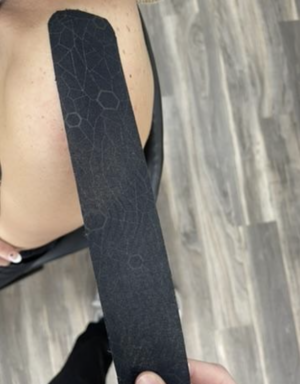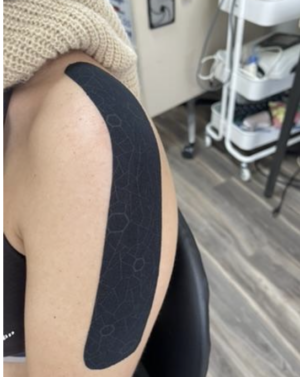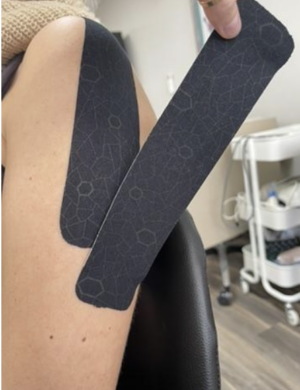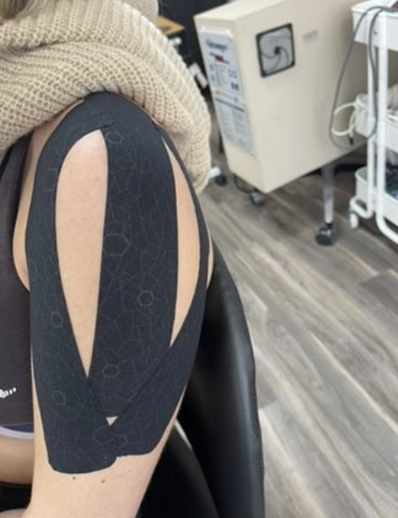How to use Kinesiology Taping for Shoulder Subluxation
Filed under Treatments
How to us Kinesiology Tape for Shoulder Subluxation
By: Tayler Roost
What is shoulder subluxation?
Shoulder subluxation is a dislocation of the glenohumeral joint. This can be classified as traumatic, non-traumatic, or neurological. A traumatic shoulder subluxation can be caused by contact sports or repetitive shoulder movements. A non-traumatic shoulder subluxation can be caused indirectly by another injury such as a rotator cuff tear. A neurological shoulder subluxation can stem from diagnoses such as a stroke, spinal cord injury, or brachial plexus injury. Whatever the category of subluxation is, it affects the person’s ability to functionally use their arms, especially during lifting, flexing, and abducting their affected shoulder.
How to know when someone has shoulder subluxation?
The person will usually present with pain in the shoulder, loss of range of movement, and a palpable gap between the humeral head and the acromion. The subluxation is typically measured in finger width. Special tests can be completed as well to identify if there is a subluxation such as the load and shift test, apprehension test, and relocation test.
How to use kinesiology tape for subluxation support:
- Cut 3 strips of kinesiology tape into 6in-8in pieces with rounded corners

- Anchor at the top of the deltoid


- Add a second piece, anchoring at mid-arm, stretching to approximately 30-50%, and attaching at the upper trapezius with shoulder approximated
- Add a third piece following the same steps as above anchoring at mid-arm, stretching to approximately 30-50%, and attaching at AC joint area with shoulder approximated


- Rub to adhere and they should be good to go! Ensure skin integrity and patient satisfaction after application.
Reference:
Chang, K., & Vitoonpong, T. (2023). Shoulder subluxation – statpearls – NCBI bookshelf.
National Library of Medicine. https://www.ncbi.nlm.nih.gov/books/NBK507847/
1 Comments
Leave a Comment
More To Read
Prevention and Management of UE injuries in Modern Mass Production
Reference: Pitts, G., Custer, M., Foister, R. D., & Uhl, T. (2021). The hand therapist’s role in the prevention and management of upper extremity injuries in the modern mass production industrial setting. Journal of Hand Therapy, 34(2), 237–249. https://doi.org/10.1016/j.jht.2021.04.019 By: Kaylen Kallander The Skinny: This study included four case studies to determine the impact of…
Read MorePillar Pain After Carpal Tunnel Release Surgery
Pillar Pain After Carpal Tunnel Release Surgery Carpal tunnel release (CTR) surgery is a common procedure, with the majority of patients experiencing satisfaction with its outcomes. However, for some individuals, a temporary complication known as “pillar pain” may arise, affecting approximately 13% of those undergoing CTR. Pillar pain manifests in the thenar eminence and hypothenar…
Read MoreGot Wounds? How to manage them as a Hand Therapist.
Wound care is messy. It can be intimidating and scary with so many variations of wounds (for example, white skin around wounds) and so many products out there, it is hard to know what to use, when to use it, and how to use it. If you go to a wound care conference, you’ll spend most of…
Read MoreSign-up to Get Updates Straight to Your Inbox!
Sign up with us and we will send you regular blog posts on everything hand therapy, notices every time we upload new videos and tutorials, along with handout, protocols, and other useful information.





This article on kinesiology taping for shoulder subluxation is very informative. I appreciate the detailed instructions and emphasis on proper assessment. The examples and videos provided make it easy to understand and implement. Thank you, Hand Therapy Academy, for this valuable resource!